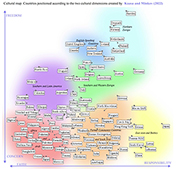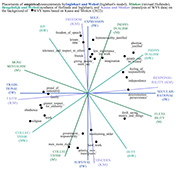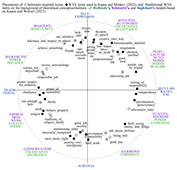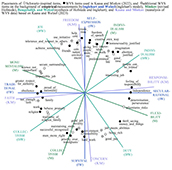The main aim of the project was to improve the measurement of culture by providing indicators of culture that 1) are up-to-date, 2) are based on data from entire populations, 3) are available at both country and regional (within-country) level, 4) cover many countries, 5) capture contemporary cultural differences, and 6) are available at multiple time points.
In the first stage, different existing models for measuring culture were mapped. The most important result of this stage is a theoretical research article (Kaasa, 2021), which links the three most well-known cultural models (Hofstede, Schwartz, Inglehart) into a single system and shows how the cultural dimensions of these models relate to each other: what is similar to what.
How these models can be systematized based on keywords used in conceptualisation of different models can be seen in this figure:

A comprehensive scheme of how the three most well-known cultural models (Hofstede, Schwartz, Inglehart) are conceptually related to each other can be seen in this figure:

Next, the data available from various international studies were mapped. WVS/EVS turned out to be the best choice in terms of both coverage of different aspects of culture questions and coverage of different regions and time periods.
In the second stage, new indicators to measure culture based on data from the whole population were calculated from the WVS/EVS data. Scores for two dimensions (freedom-concern and responsibility-faith, similar to Ingelhart's dimensions) are now available (Kaasa & Minkov, 2022) for 115 countries. Data are available for six periods from 1990-2020. For European countries, there are also scores for within-country regions (Kaasa & Minkov, 2022, online appendix). It is also possible to calculate new scores from future waves of WVS/EVS.
Based on the scores of these dimensions, a cultural map was also prepared, which gives an idea of the cultural distance of different countries from each other. The cultural map can be seen in this figure:

Further, it was empirically investigated how the created set of cultural dimensions is related to other cultural models for which up-to-date data are available. These other modern cultural models are also all two-dimensional: Inglehart's model, Minkov's revised Hofsede model, and Beugeldsijk and Welzel's attempt to synthesize the Hofstede and Inglehart model. It turned out that these models are all rotations of each other, as can be seen in this figure:

How this empirical synthesis relates to the above-mentioned scheme synthesizing the three most well-known cultural models (Hofstede, Schwartz, Inglehart) can be seen in this figure:

Since different dimensions can be most suitable for describing different phenomena, up-to-date indicators were also created for the revised Hofstede or Minkov model. They are available for 102 countries (Minkov & Kaasa, 2022).
Since the empirical synthesis described above did not cover Schwartz's model, another study was conducted to obtain a complete overview. By including additional questions from the WVS that are not asked in all waves, the elements of the Schwartz model were also empirically positioned in a system of different models (Kaasa ja Welzel, 2023).
How the elements of Schwartz's model are positioned in the scheme synthesizing the three most well-known cultural models (Hofstede, Schwartz, Inglehart) can be seen in this figure:

How the elements of Schwartz's model relate to various contemporary empirical cultural models can be seen in this figure:

In the third stage, the created set of cultural dimensions was tested in comparison with scores of other older and newer cultural dimensions in explaining various phenomena. In the comparison, it turned out that the new indicators of culture really have a greater explanatory power than, for example, the dimensions published by Hofstede or Schwartz. Several specific studies were conducted in the project, but simple correlation tables provide a good overview of the explanatory power of different cultural models (Kaasa & Minkov, 2022).